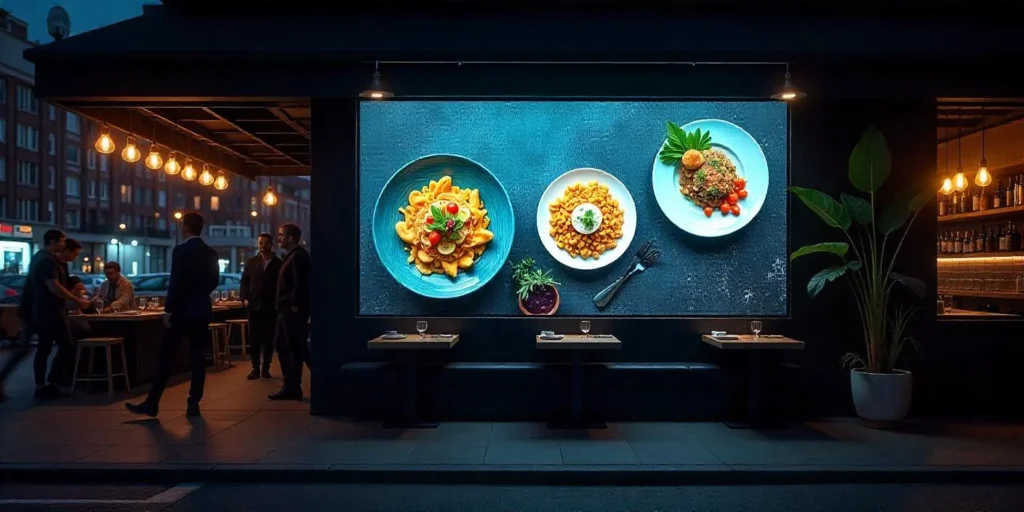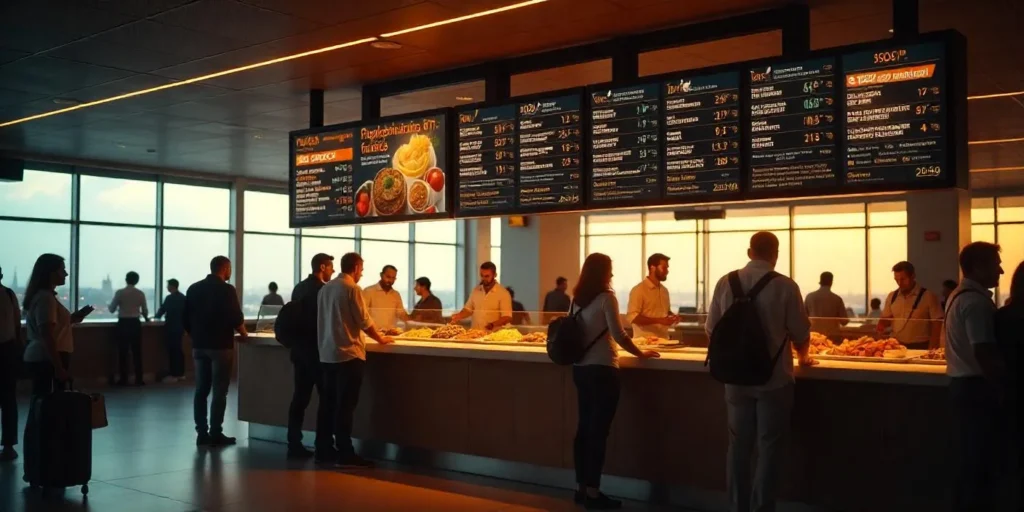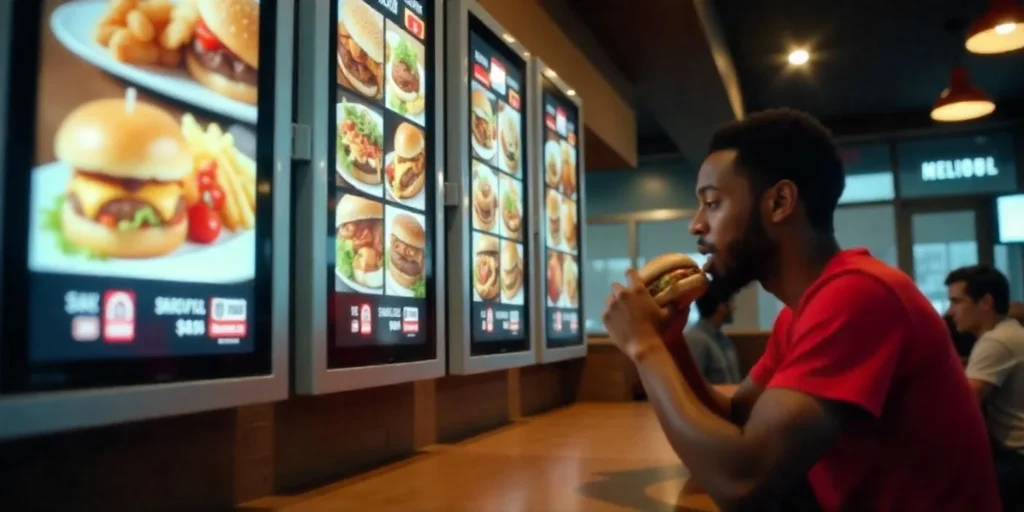Introduction to Digital Menu Boards
The static chalkboards and paper menus have taken a back seat as the digital menu boards have come up with colorful digital menu board concepts that immediately attract the attention of diners. With the use of digital menu boards in restaurants, immersive experience can be achieved by the use of dynamic images, animations, and live specials. Not only do these menu board designs make operations efficient, minus the delays and expenditures that accompany printing, but they also enhance brand recognition and encourage guest participation as soon as they step into your establishment.
Why Digital Menu Boards Are Revolutionizing Restaurant

The revolution is an outcome of the capacity to refresh offerings on the fly. Using digital menu solutions, you can automatically change breakfast to brunch to dinner menus, with seasonal or special offerings in your menu board to your restaurant displays. This rapidness enables restaurants to act quickly to any inventory adjustment, fluctuation in supply, and trending customer preferences. In addition, menu board design concepts like animated callouts on upsells increase average checks and do not require wait staff intervention.
Benefits of Using a Digital Menu Board for Restaurant Settings
Visual Appeal & Brand Consistency
Restaurant-ready high-resolution digital menu boards allow you to display high-quality food images; chef demos with a continuous loop, and branded graphics that have a consistent appearance across all restaurants. Horizontal brand colors and typography in the design of your digital menu boards will give you a strong brand recall and a professional image.
Real-Time Menu Updates
Bye-bye to expensive reprints. Using the digital menu board concept in restaurants, it is possible to edit prices, out-of-stock products, and special deals in real time through a cloud-based CMS. This is to make sure that your digital display of the restaurant is always up to date in regard to available products and their prices.
Dynamic Content upselling
You will see animated upsell messages on your restaurant menu screens, such as adding garlic fries at $1.50 to your order. With sales data, you can best work out these digital menu board concepts to promote the most profitable combinations during peak times.
Better Customer Experience
Digital menu boards that are interactive minimize confusion by providing allergen filtering, nutritional information pop-ups, and multilingual options. Your digital menu solutions will turn into engines for customer satisfaction, as guests will be empowered, informed, and more willing to come back.
Understanding the Psychology Behind Menu Board Design
The good design of a menu board uses psychology: the human eye attracts motion, sharp contrasts, and little writing. Placing high-profit items in the upper right-hand hot zone, applying warm color accents to specials, and restricting options in each screen frame would all lessen decision fatigue and guide the customer into your most profitable items. Adding minor countdown clocks to the design of digital menus can also create a sense of urgency, pushing customers to buy time-sensitive products.
Creative Digital Menu Board Ideas for Restaurants

Animated Ingredient Spotlights: Play snippets of food sizzling on the barbecue or pouring gravy to build up the senses.
Chef Recommendation Features: Add personality and trust to your digital menu board with embedded brief chef cameo videos introducing the day-to-day specials.
Social Proof Overlays: Switch real-time social media testimonies or customer pictures with your restaurant hashtag, which increases authenticity.
Behind-the-Scenes Snippets: Show chefs plating the food or purchasing the ingredients and making your brand more human and connecting with the guests.
Build Your Carousels: Allow customers to combine and customize their ingredients, toppings, sides, sauces, and so on right on-screen, and make the process of ordering an interactive one.
Interactive Menu Board Features That Drive Engagement
Restaurant touch-enabled digital menu boards turn passive watching into active discovery. They allow guests to filter by diet- vegetarian, gluten-free, paleo or see allergen information. The menu is interactive and informative because QR codes on your digital menu lead to loyalty sign-ups, mobile ordering, or information about the sourcing of ingredients.
Seasonal and Time-Based Menu Board Content
Program your digital menu board to rotate morning coffee specials, lunchtime combos, then dinner entrees, and each change will be coordinated with your schedule of service. The calendar is supported with seasonal overlays (fall leaves or spring flowers) and themed promotions (Summer Berry Tart) that will excite the returning customers and demonstrate your changing digital menu board concepts.
Dynamic Upselling Through Smart Menu Board Design
Digital menu board concepts are innovative because sales analytics are used to highlight popular add-ons. In case there is an increase inside salads, the board will auto-feature them alongside major dishes. Digital menu board design, with the help of AI, even makes suggestions to repeat guests based on their previous orders, which further increases the feeling of individual attention.
Integration with POS Systems for Seamless Updates
A well-developed digital menu will be directly connected to your POS, so when you run out of an item, it will automatically disappear from your digital menu boards in restaurants. Prices, new dishes, and promotion switches are reflected on all screens, both front-of-house menu boards and self-service kiosks, in real time, reducing errors and maximizing efficiency.
Branding Through Custom Digital Menu Board Designs
Your restaurant’s digital display must be a representation of your own personality. Personalize templates by adding your logo, color scheme, and favorite fonts. Animated transitions and seasonal skins add to branding, and making the digital menu boards cohesive means every screen, whether it is in a fast-casual cafe or high-end bistro, tells the same brand story.
Digital Menu Boards for Quick-Service vs. Fine Dining

• QSRs need transparency and swiftness. Large fonts, few words, and turning combo meal offers keep queues going.
• Fine Dining is all about class. The cinematic imagery of serving plates, accompanied by ambient background loops, allows the production of a sophisticated menu presentation, which suits the high-end atmosphere.
Adjust the digital menu board ideas for restaurant to align with the services and customer anticipation.
Digital Menu Board Design Ideas for Cafés and Coffee Shops
Cafes operate in a warm atmosphere. Adopt a digital chalkboard feel – hand-written fonts, steaming animation, turning quote-of-the-day slides. Emphasize seasonal lattes and baked goods with humorous digital menu board concepts to support your restaurant themes that strengthen the personality of your cafe.
Multilingual Digital Menu Boards for Diverse Audiences
In tourist centers or international neighborhoods, provide language switches on your electronic menu board rotating between English, Spanish, Mandarin, or French. The touch-selectable options make all the guests feel at home and be able to order confidently, eliminating misunderstandings and optimizing the service process.
Eco-Friendly Benefits of Digital Menus Over Traditional Boards
The use of digital menu solutions helps to avoid paper waste printing overruns and shipping emissions. Every digital menu board has one less environmental impact, which will attract sustainable customers who prefer to see a company with green values and support its brand.
Future Trends in Digital Menu Board Technologies

The AI-derived personalization will enable the designs of digital menu boards to customize content according to weather, time, and guest behavior. Menus that can be activated by voice, such as “Show me vegan options,” will increase accessibility, and augmented reality previews of the dishes allow customers to see what they are ordering in 3D, taking digital menu board concepts into novel interactive spaces.
Best Practices for Implementing Digital Menu Boards
• Keep high contrast and large sans-serif fonts so that it can be readable at any distance.
• Each slide should be no longer than 10-15 seconds so that the content is fresh and not overloaded.
• Post regular content changes, such as daily specials, promotions, and loyalty offers, to keep the guests interested.
• Train personnel in emergency editing and ad hoc content modification to be as responsive as possible.
• Design digital menus on both small screens (32″ displays) as well as on large video walls to ensure uniformity and effectiveness.
Elevate Your Dining Experience with Innovative Digital Menu Board Ideas
With the adoption of innovative digital menu board ideas, restaurants will be able to provide memorable experiences to their guests, improve back-of-house processes, and open up new revenue channels. Whether it be digital menu boards for restaurants or interactive tabletop kiosks, the proper implementation of digital menu solutions will make your brand stand out in the current competitive restaurant environment. It doesn’t matter whether you’re a cozy cafe or a fancy bistro; it is time to turn your menus into dynamic revenue-generating digital menu board designs.
FAQs About Digital Menu Boards
Q1: Are digital menu boards expensive to set up?
The initial expenses are different, yet the savings on the printing and labor quickly pay off the investment, which makes the idea of digital menu boards cost-effective.
Q2: Can I manage multiple locations from one system?
Yes, cloud-based systems bring together the management of all the digital menus in restaurants in a single dashboard.
Q3: Do I need a graphic designer?
A majority of systems come with drag-and-drop digital menu board templates so that non-designers can make professional layouts.
Q4: Do digital menu boards increase sales?
Absolutely. Check averages can be increased by 10-20 percent with dynamic upsells, targeted promotions, and appealing visuals.
Q5: Are digital boards secure?
The best sites provide encryption, authentication, and locking of users remotely.
Q6: Do they need internet to run?
Although updates need connectivity, the vast majority cache content locally so that it can be displayed without interruption.





